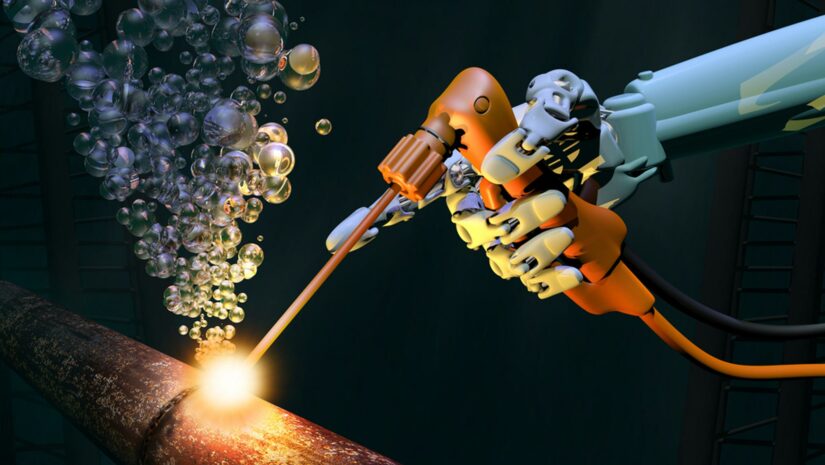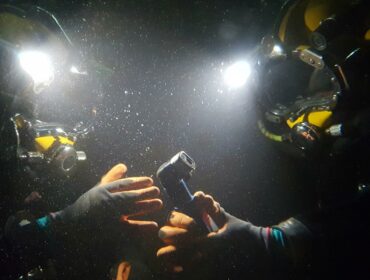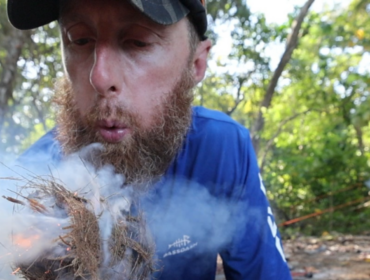As a diver, you’ve likely heard of the term “underwater welding” before. Underwater welding is one of the most well-known (and lucrative) jobs available to commercial divers.
Most people have a basic understanding of welding, but how exactly is it performed underwater? Below, we learn more about this interesting yet dangerous career.
What is Underwater Welding?
Underwater welding, often referred to as hyperbaric welding, has existed since the early 1930s and is still performed in many parts of the world to maintain and repair marine infrastructures that are partially or fully submerged in water. Inland welders work on bridges, dams, and small water vessels, while offshore welders handle pipelines, oil rigs, large ships, underwater habitats, and even nuclear power facilities.
Welding underwater is not that different from welding on dry land. Both use the same basic welding techniques and equipment, which is why underwater welders typically train to become certified welders above water first. Nonetheless, it is a dangerous field of work that requires years of training to gain not only the required knowledge and skill set but also the necessary certification from an accredited commercial dive school.
The first thought that comes to people’s minds when talking about underwater welding is the danger of mixing water and electricity. Indeed, this is one of the threats of the job, but surprisingly not the biggest one (more about the Dangers of Underwater Welding below). Yet, many choose this career path for the excitement and challenges of the job, not to mention a good payout of an average of $53,990 a year (or more for offshore welder-divers).
Although the job generally involves the use of a specialized welding stick (or electrode) and gaseous bubbles, there are two main types of underwater welding:
Dry Welding
Although we normally picture underwater welding being done while fully submerged in water, most is done in dry habitats. Dry welding uses a dry chamber or habitat (hyperbaric chamber) where water is replaced by a mixture of gas so one or multiple welders can do the job in dry conditions.
These chambers can be expensive, and welder-divers don’t always have them at their disposal. In this case, welder-divers must resort to wet welding, with nothing shielding them from water.
Wet Welding
Wet welding is done depending on the accessibility of the welding area and the severity of the repair needed. Aside from the obvious danger of using electricity in water, wet welding is used mostly as a last resort because the weld can cool down too quickly due to the temperature of the surrounding water, thus increasing the chance of cracking.
We’ll also learn how each type of welding works below.
How Does Underwater Welding Work?
So how is welding performed underwater? Surprisingly, there are several ways that welder-divers do it. After being given an assignment, project managers and expert welder-divers choose between several types of underwater welding that will best suit their needs. Please find out more about their specific welding processes below.
Wet Welding
Most of the time, divers use Shielded Metal Arc Welding (SMAW) or “stick welding” as it is the most cost-effective and versatile method for wet welding. This method produces an electric arc between their electrode and the infrastructure metals (like stainless steel and aluminum) that will be welded together.
Welder-divers must keep their electrodes clean. Once they’ve reached the weld area, divers usually check the surroundings for obstructions or safety hazards before performing the weld.
When the diver is ready, they start by placing their electrode on the target surface and signaling their team to flip the current on, generating 300 to 400 amps of electricity via direct current (DC).
The key to how the diver doesn’t get electrocuted is the thick layer of gaseous bubbles that the flux (or external coating) of the electrode creates to cover the weld and shield the electricity from water, corrosive gases, and other oxidizing compounds. The team also uses direct current (DC), as it is safer and more effective to use underwater than alternating current (AC).
Other common types of wet underwater welding methods include:
- Flux-cored Arc Welding (FCAW) uses a continuously fed filler metal or electrode to weld nickel-based alloys and cast iron metals, among others.
- Friction Welding (FW) – Uses high friction and heat instead of material melting to fuse metal or thermoplastics.
Dry Welding
As previously mentioned, dry welding or habitat welding involves using a hyperbaric chamber while referring to the same basic welding process. After creating a seal around the structure that needs to be welded, connect hoses to flush water out and replace it with a mixture of gases, like helium and oxygen.
After pushing all the water out, the hyperbaric chamber will be pressurized to the correct depth to avoid decompression sickness.
The technique that will be used will depend on the size of the chamber.
Four types of dry welding methods that welder-divers choose from:
- Pressure Welding – This method works in a pressure vessel, which measures approximately one atmosphere unit of pressure (similar to sea-level pressure).
- Habitat Welding: The welder-diver uses a small, room-sized chamber with the same pressure outside it (ambient pressure) at working depth. The chamber displaces the water into the surrounding body of water before the welder-diver enters.
- Dry Chamber Welding: The welder diver enters the small chamber from underneath and is covered only from the head down to the shoulders (with diving gear).
- Dry Spot Welding: his technique is used for clear chambers and is about as small as a person’s head. The electrode is placed on the weld site, and the welder-diver must insert it into the habitat, which will conveniently seal around it.
Shielded Metal Arc Welding (SMAW) and Flux-cored Arc Welding (FCAW) are also used during dry underwater welding.
Other Common welds:
- Gas Tungsten Arc Welding (GTAW): Also referred to as “TIG,” this welding process uses a non-consumable tungsten electrode. Heat and an electric arc are applied to stainless steel, aluminum, and other metals that need to be welded.
- Gas Metal Arc Welding (GMAW): Also referred to as “MIG,” it is known for its various metal transfer methods. This method uses shielding gas that runs through the welding gun around the electrode to weld non-ferrous metals like aluminum.
- Plasma Arc Welding (PAW): Also makes use of an electric arc, but the arc is constricted to produce a high arc (plasma) speed and intense heat for welding stainless steel, aluminum, and other metals.
For extensive deep underwater welds inside large hyperbaric chambers, welder-divers usually work in pairs. Once the operators have lowered the chamber to the weld site and filled it with gas, the welders will drop to the same depth (in a diving bell), swim into the chamber, and start the weld, often alternating between 6-hour and 8-hour shifts.
For a visual explanation of how wet and dry underwater welding works, check out the video below by Water Welders:
Dangers of Underwater Welding
Since underwater welders have way more variables to work with—different atmospheric gas, water and gas pressures, specialized diving and welding equipment, and limited space, in addition to water and electric current supply—it is a field only for expert welder-divers (including engineers and managers) who are fully prepared to avoid risks and handle dangers, such as the following:
- Drowning – Usually caused by Delta P hazards, or differential pressure, where a major water pressure difference causes a diver to get stuck in a bottleneck where water is rushing to fill another space with great force, sometimes equal to over a thousand pounds of pressure.
- Explosions – Can happen when hydrogen and oxygen gases mix and build up in pockets.
- Electric shocks – Often the biggest concern when dealing with water and electricity, particularly when inexperienced welders don’t use direct current (DC) to supply power.
- Decompression sickness – A common concern in underwater diving, caused by the build-up of nitrogen bubbles in the bloodstream
- Hypothermia – Result of working in dark and cold water conditions for many hours a day.
Safety precautions include being tethered to the surface, having another welder-diver to assist and monitor the primary welder/s /divers, and communicating with the team throughout the welding operation. Fortunately, welding courses will train you for these circumstances and more. And if you’re interested in starting a career in underwater welding, check our guide on how to become an underwater welder.





